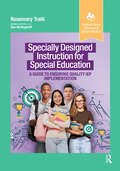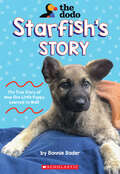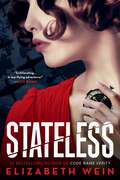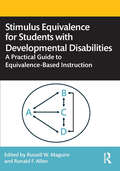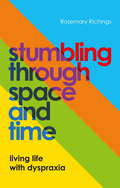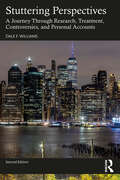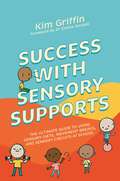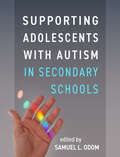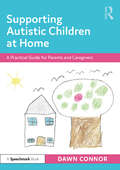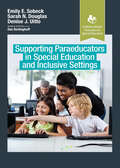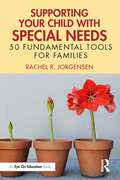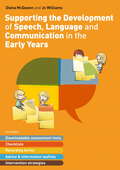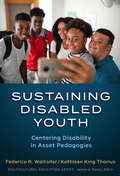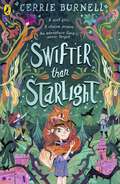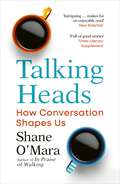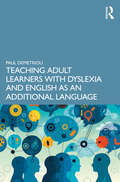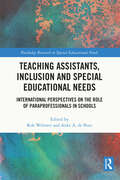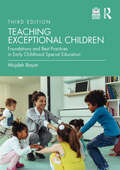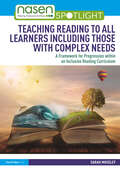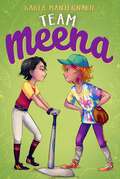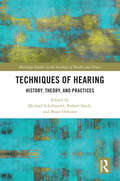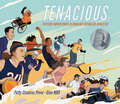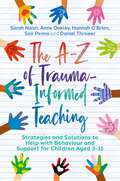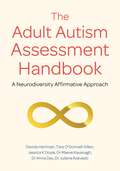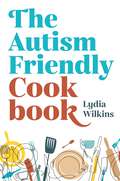- Table View
- List View
Specially Designed Instruction for Special Education: A Guide to Ensuring Quality IEP Implementation (Evidence-Based Instruction in Special Education)
by Rosemary TralliA new resource for teacher preparatory programs at institutes of higher education and school-based professional development, Specially Designed Instruction for Special Education: A Guide to Ensuring Quality IEP Implementation offers a detailed account of the legal requirements and evidence-based practices for educators to afford quality specialized instruction to eligible students.The latest entry in SLACK’s Evidence-Based Instruction in Special Education series, Specially Designed Instruction for Special Education provides educators with practical tools to define, plan, implement, and assess educational conditions and practices. After reading this text, special education teacher candidates and educators will possess the knowledge and skills to ensure student success through specially designed instruction, align interventions with student strengths and needs, and engage in collaborations to develop and implement quality Individualized Education Programs.What’s included in Specially Designed Instruction for Special Education: Individuals with Disabilities Education Act connections with references to federal regulations and relevant court cases Evidence-based practices and tools that support specialized instruction Key takeaways that summarize concepts and practices associated with the chapter content Included with the text are online supplemental materials for faculty use in the classroom.Specially Designed Instruction for Special Education provides readers with a comprehensive understanding of the composition and conditions of specialized instruction and the tools to ensure their adherence to the legal and programming components of specialized instruction.
Starfish's Story (The Dodo)
by Bonnie BaderThe true story of how one little puppy learned to walk -- as seen on The Dodo!When Starfish was rescued from a California beach, this Belgian Malinois puppy couldn't stand. That's because Starfish had swimmer puppy syndrome, which meant her leg muscles hadn't developed properly. If Starfish was going to walk, she would need help from a lot of new friends.Luckily, a team of doctors, therapists, and Starfish's family all worked together to encourage and support her. This true story teaches us what it means to never give up hope. With some love, hard work, and a "can-do" attitude, Starfish reached her goals and inspired everyone around her.This story is perfect for middle-grade readers and comes with eight pages of full-color photos!
Stateless
by Elizabeth WeinIn this historical thriller from the bestselling author of Code Name Verity, Stella North enters an air race competition as the only woman—and finds herself thrown into a mystery she must solve before it kills her. When Stella North is chosen to represent Britain in Europe&’s first air race for young people, she knows all too well how high the stakes are. As the only participating female pilot, it&’ll be a constant challenge to prove she&’s a worthy competitor. But promoting peace in Europe, the goal of the race, feels empty to Stella when civil war is raging in Spain and the Nazis are gaining power—and when, right from the start, someone resorts to cutthroat sabotage to get ahead of the competition. The world is looking for inspiration in what&’s meant to be a friendly sporting event. But each of the racers is hiding a turbulent and violent past, and any one of them might be capable of murder—including Stella herself. Agatha Christie meets Karen McManus in this thrilling mystery, packed with adventure, intrigue, love, and betrayal, from bestselling and award-winning author Elizabeth Wein.
Stimulus Equivalence for Students with Developmental Disabilities: A Practical Guide to Equivalence-Based Instruction
by Russell W. Maguire Ronald F. AllenStimulus Equivalence for Students with Developmental Disabilities provides a step-by-step program for converting lesson plans into equivalence-based instruction. Using language and tools accessible to both students and practitioners, chapters present the concept of equivalence-based instruction and include clear and concise procedural descriptions, as well as data sheets and PowerPoint slides, with replaceable stimuli, so that special educators and clinicians will be able to immediately implement this procedure to teach any academic skill. Written in engaging prose with an emphasis on practical application, this book is an essential resource for special educators and graduate students studying to become BCBAs and special educators.
Stumbling through Space and Time: Living Life with Dyspraxia
by Rosemary Richings"In 1994, I was diagnosed with dyspraxia, and I was unable to do everything that children are expected to do by the time they're in school. For me, this included everything from riding a bike and catching a ball, to reading, writing, and basic math."When talking about her dyspraxia, Rosemary Richings is often met with confusion. Why do so few people understand dyspraxia, or even know what it is?Rosemary shares her experience of growing up dyspraxic, and how it impacts her sense of space, time and co-ordination. Diagnosed with DCD at the age of four, Rosemary shares her insights and experience dealing with challenges, from coping with bullies in school to choosing a dyspraxia-friendly university, pursuing self-employment and travelling abroad.Rosemary shares guidance for others about what helped her develop her skills, including ballet and gymnastics, the Wilbarger Protocol (brushing therapy) and equestrian therapy. Full of practical tips and insights into the strategies that gave Rosemary the confidence to succeed, this is an essential guide for other dyspraxics and those supporting them, which shows you how you too can thrive as a dyspraxic person.
Stuttering Perspectives: A Journey Through Research, Treatment, Controversies, and Personal Accounts
by Dale F. WilliamsStuttering Perspectives is a highly engaging book that interweaves discussion and research about stuttering with personal accounts. Written in a reader-friendly and informal style, the book considers stuttering from a variety of angles, providing the reader with a nuanced and holistic view. In this way, topics such as therapy, support groups, listener reactions, and many others are not only explained within the context of current research, but also illustrated with lively examples demonstrating the stuttering experience. Fully updated in its second edition, the book includes new stories, additional discussion questions, and inclusion of contemporary stuttering issues not contained in the original version. This book is highly relevant reading for speech and language professionals, as well as students of communication sciences and disorders. It will also be of great interest to people who stutter and anyone with an interest in fluency disorders.
Success with Sensory Supports: The ultimate guide to using sensory diets, movement breaks, and sensory circuits at school
by Kim GriffinSensory needs are being recognised as a vital part of learning, development and engagement within the classroom and are being used more often to make education both accessible and fun. To harness the full potential of sensory supports, using these strategies correctly is key!This is the essential guide to using sensory strategies successfully with school children, from occupational therapist, Kim Griffin, who has 20 years of experience supporting sensory needs.As you make your way through the book, you will be joined by Isla and Noah, two children whose stories will help illustrate how information in the book can be used practically. In addition, the book includes personal anecdotes from Kim, links to further reading, reflective questions and teacher perspectives to show how a teacher might use the information in the classroom. These features will help you easily identify sensory needs and use sensory tools effectively.
Supporting Adolescents with Autism in Secondary Schools
by Samuel L. OdomIn a convenient large-size format, this book presents the first research-based, comprehensive program designed to support high school students with autism spectrum disorder (ASD). Developed and tested in public schools by the Center on Secondary Education for Students with Autism Spectrum Disorder (CSESA), the program addresses four critical areas--literacy, social competence and peer relationships, independence, and postschool transition preparation for students and their families. Chapters provide a roadmap for implementation of each component, complete with intervention guidelines, case vignettes, key findings, lessons learned, and reproducible forms that can be downloaded and printed at the companion website. The book also helps readers navigate the wealth of additional resources freely available from CSESA.
Supporting Autistic Children at Home: A Practical Guide for Parents and Caregivers
by Dawn ConnorThis practical guide offers a wealth of advice to support parents and caregivers who have an autistic child within their family. It provides accessible and straightforward information on the topics that matter most, from initial questions around diagnosis, to providing the best home support. Chapters also debunk myths commonly held about autism and signpost appropriate support mechanisms, including ideas to help with sleep, diet, sensory sensitivities, social interactions, communication, and much more. The emphasis throughout is on offering practical strategies to give much-needed, meaningful support to the child’s main caregivers and other family members, in an easily digestible format. Written from the author’s joint perspective as a qualified teacher with an expertise in autism, and as a grandmother of an autistic grandchild, this book is an essential guide for parents and caregivers, created by someone who understands and appreciates what it is like to walk in their shoes.
Supporting Paraeducators in Special Education and Inclusive Settings (Evidence-Based Instruction in Special Education)
by Sarah Douglas Emily Sobeck Denise UittoSupporting Paraeducators in Special Education and Inclusive Settings provides an in-depth look at the role of pre- and in-service teachers as supervisors of paraeducators within special education and inclusive settings.The latest entry within the Evidence-Based Instruction in Special Education series, Supporting Paraeducators in Special Education and Inclusive Settings serves as an instructional tool for pre-service teachers and educators within higher education coursework, as well as a resource for in-service teachers. This text supports teachers in strengthening their knowledge and supervisory skills necessary to supervise and manage paraeducators in educational environments.Through objectives, scenarios, content, and chapter questions, Drs. Sobeck, Douglas, and Uitto provide a thorough and applicable overview of working with and supervising paraeducators. In this text the roles and responsibilities of paraeducators, teachers, and school administrators relative to paraeducator training and supervision will be detailed, as well as tips for collaboration.Included with the text are online supplemental materials for faculty use. School leaders and higher education faculty can use the online site for materials to support pre-service training within teacher preparation programs and professional development for in-service teachers.Supporting Paraeducators in Special Education and Inclusive Settings fills an important need in the field and is a vital resource for current and future teachers when working with paraeducators.
Supporting Your Child with Special Needs: 50 Fundamental Tools for Families
by Rachel R. JorgensenSupporting Your Child with Special Needs offers practical activities and strategies to help you prepare your children for school success and best connect with school personnel to meet your child's unique needs. Each of the ten chapters includes key themes supported by research as well as activities for you to complete with your children to bond with and build them up. Rachel Jorgensen's guidance will help you both understand and tackle the real-world situations you'll encounter as a parent navigating the special education system. You will find yourself better equipped to support your child in the school setting and better able to prepare your child for a path to greater independence in adulthood.
Supporting the Development of Speech, Language and Communication in the Early Years: Includes Downloadable Assessment Tools, Checklists, Recording Forms, Advice and Information Leaflets and Intervention Strategies
by Jo Williams Diana McQueenSpeech and language impairment can have a huge impact on cognitive development. Identifying what is going wrong and what effective intervention looks like can be daunting. Short of retraining you as a speech and language therapist, this thorough guide will give you everything you need to change that.An essential resource, the book contains a wide variety of online resources, including phonological and sound awareness documents, assessment tools, and recording forms that can be downloaded straight to your device, providing excellent materials and activities to use in the classroom.Written by speech and language therapists and designed exclusively for Early Years practitioners, this book provides a complete overview of how children acquire language and what language impairments look like at this age. You will find both strategic and practical advice on how to manage and encourage the development of speech and language skills. Creating the optimum communication environment for every child in your setting is an important part of what the book offers. Equally, practitioners are supported to be able to recognise the features of specific language difficulties such as Developmental Language Disorder (DLD) and feel confident to intervene when children are struggling.
Sustaining Disabled Youth: Centering Disability in Asset Pedagogies (Multicultural Education Series)
by Frederico R. Waitoller Kathleen A. King ThoriusAsset-based pedagogies, such as culturally relevant/sustaining teaching, are frequently used to improve the educational experiences of students of color and to challenge the White curriculum that has historically informed school practices. Yet asset-based pedagogies have evaded important aspects of students’ culture and identity: those related to disability. <P><P> Sustaining Disabled Youth is the first book to accomplish this. It brings together a collection of work that situates disability as a key aspect of children and youth’s cultural identity construction. It explores how disability intersects with other markers of difference to create unique cultural repertoires to be valued, sustained, and utilized for learning. <P><P>Readers will hear from prominent and emerging scholars and activists in disability studies who engage with the following questions: Can disability be considered an identity and culture in the same ways that race and ethnicity are? How can disability be incorporated to develop and sustain asset-based pedagogies that attend to intersecting forms of marginalization? How can disability serve in inquiries on the use of asset-based pedagogies? Do all disability identities and embodiments merit sustaining? How can disability justice be incorporated into other efforts toward social justice?
Swifter than Starlight: A Wilder than Midnight Story (Wilder Than Midnight)
by Cerrie BurnellFrom celebrated children's author Cerrie Burnell comes a new, wonderfully inclusive, magical tale set in the whimsical world of Wilder than Midnight.Long ago, on a winter's eve, two sisters walked into a wolf-wild wood but only one returned. . .The Faraway Wood is full of twisting thorns and sharp teeth. Stirring with myth and music. It's the perfect place for bandits, thieves and secrets to hide.Until a prince goes missing.Lilac is a strong girl, happy with her found family, yet searching for her sister.Clover is a determined girl, eager to find what's been lost to her, though scared to leave her village.Hester is a smart girl, one step ahead of trouble, and ready for adventure.Together, they will unite the realm.Praise for Wilder than Midnight:'Guaranteed to bring beauty, magic and joy into the hearts of all who read it' - Sophie Anderson, author of The House with Chicken Legs'Pure fairytale magic with so many twists' - Jasbinder Bilan, author of Asha and the Spirit Bird'[a] book about love and friendship and driving your own destiny in the face of prejudice. But mostly, it's a story of girls, glorious girls, in all their feisty, feminine brilliance' - Nizrana Farook, author of The Girl Who Stole an Elephant
Talking Heads: The New Science of How Conversation Shapes Our Worlds
by Shane O'MaraFrom neurons to nations, Talking Heads is a stunning survey of the science of human connection and communication.'Delightfully well-written' IRISH TIMES'Intriguing ... Makes for an enjoyable read' NEW SCIENTIST'Full of good stories' TIMES LITERARY SUPPLEMENTTalking to each other is a primal behaviour. It’s a key part of what makes us human. Yet the science of human connection has largely remained a mystery. Only recently have scientific advances allowed us to peer into the purpose of conversations and uncover their extraordinary impact.In this groundbreaking book, the first of its kind written by a leading neuroscientist, Professor Shane O’Mara expertly reveals how talking affects all our lives. What does it mean that we mostly think, and speak, in five-minute bubbles around the present moment? Is the fact that we instinctively trust what others say empowering or a hindrance? And how do our very nations begin as conversations?Moving from the personal to the social and ultimately towards an urgent and radical new perspective on the defining phenomenon of our times, populist nationalism, Talking Heads is the story of how conversation shapes us and constructs our worlds – and how, together, we can talk our way into a better tomorrow.
Teaching Adult Learners with Dyslexia and English as an Additional Language: Practical Tips to Support Best Practice
by Paul DemetriouPacked full of practical tips to use in the classroom, case studies to provide theoretical grounding and ideas to improve inclusion, Teaching Adult Learners with Dyslexia and English as an Additional Language covers all the key areas necessary to ensure inclusive and effective teaching practice in higher and further education settings. This book provides a coherent framework for those looking to develop their knowledge and skills in this challenging area and explores key areas such as: teaching and learning strategies, differentiation, assessment, feedback and supporting students using technology. It provides a unique insight into how to develop a thorough understanding of the needs of learners and the principles and practices of how to meet those needs within a classroom setting. This is an essential introductory book for anyone working or training to work in either Further or Higher Education and who wishes to develop knowledge and skills in the challenging area of supporting and teaching adult EAL learners with learning differences.
Teaching Assistants, Inclusion and Special Educational Needs: International Perspectives on the Role of Paraprofessionals in Schools (Routledge Research in Special Educational Needs)
by Rob Webster Anke A. de BoerThis book offers the first collection of international academic writing on the topic of Teaching Assistants. It serves as an indicative summary of current research and thinking in this field and as a point of departure for future research and development. With contributions from leading researchers, the book draws together empirical work on the deployment and impact of Teaching Assistants from various perspectives and from a range of methodological approaches. It highlights and celebrates the vital everyday contributions Teaching Assistants make to their schools and their communities: from their role within classrooms, to their moment-by-moment interactions with pupils and teachers. The book examines the effect that Teaching Assistants can have on pupils’ learning and wellbeing, and considers issues of overdependence on classroom paraprofessionals and the unintended consequences to which this can lead. Bringing together work from a journal special issue with brand new and updated chapters, the contributions offer insight into the liminal space between educator, care-giver, behaviour manager, and facilitator of learning and of peer relations, which characterises the Teaching Assistant role. This timely and important book will be essential reading for academics, researchers and students interested in special educational needs, disability, and inclusion, and those interested in the wider topic of paraprofessionals in labour markets.
Teaching Exceptional Children: Foundations and Best Practices in Early Childhood Special Education
by Mojdeh BayatTeaching Exceptional Children is the ideal textbook for introductory graduate and undergraduate courses on early childhood special education and teaching in inclusive classrooms. Bayat’s clear and accessible writing, the text’s visually appealing design, and the focused pedagogy included in each chapter help make it possible for students and instructors to cover a significant amount of material. This powerful text identifies specific behavioral characteristics and presents theoretical information grounded in neuroscience and child development research for a wide range of disabilities. Chapters provide research-based best practices for effectively working with children with various disabilities in inclusive classrooms. This third edition has been fully updated with recent research and includes new sections on Universal Design for Learning, adaptations, technology, and common challenges in inclusive early childhood classrooms. This book is also accompanied by a robust collection of online resources for instructors and students, providing full support, including a Companion Website featuring an Instructor's Manual with additional ideas for assignments and projects, web and video links with reflection questions, a test bank, and lecture slides; and an eBook+ offering interactive links to videos, glossary terms, and more!
Teaching Reading to All Learners Including Those with Complex Needs: A Framework for Progression within an Inclusive Reading Curriculum (nasen spotlight)
by Sarah MoseleyLearning to read and having access to a rich reading curriculum has a huge impact upon us both emotionally and academically. so how can we ensure that it is seen as an entitlement of all learners, including those defined as having profound and multiple learning difficulties (PMLD) and the most complex needs? This accessible book provides professionals with the knowledge and confidence to develop reading for all learners. It integrates the latest ideas and research into a practical framework to create an inclusive reading curriculum and support learners across the whole education spectrum, including those with the most complex needs. Each chapter includes a mixture of research, strategies, and case study examples, demonstrating how reading supports both wellbeing and access to learning and - with stories - provides a versatile vehicle to build on vocabulary and expand our ability to think and learn about our place in the world. Teaching Reading to All Learners Including Those with Complex Needs is essential reading for both new and experienced teachers and special educational needs and disabilities coordinators (SENDCo)s looking to develop an inclusive reading curriculum and culture which will positively impact on the outcomes of all young people.
Team Meena (The Meena Zee Books)
by Karla Manternach&“For Junie B. graduates&” (Kirkus Reviews), the fourth and final novel in the Meena Zee series follows irrepressible Meena as she maintains a long-distance friendship with Sofía and makes new friends.No one can take Sofía&’s place. Now that her best friend lives across the country, everything reminds Meena of her. She even spends the whole week saving up things to tell Sofía in their Saturday video chats. But when Sofía gets busy with soccer friends, Meena decides to join a team of her own. Only it turns out softball is harder than she expects. So is getting along with Lin, her bossy teammate who doesn&’t even like art! It&’s not like Meena wants to be friends or anything. She still has Sofía, doesn&’t she? But can they stay close when they&’re so far apart, or is it time to expand Team Meena?
Techniques of Hearing: History, Theory and Practices
by Michael Schillmeier, Robert Stock, and Beate OchsnerHearing, health and technologies are entangled in multi-faceted ways. The edited volume addresses this complex relationship by arguing that modern hearing was and is increasingly linked to and mediated by technological innovations. By providing a set of original interdisciplinary investigations that sheds new light on the history, theory and practices of hearing techniques, it is able to explore the heterogeneous entanglements of sound, hearing practices, technologies and health issues. As the first book to bring together historians, scholars from media studies, social sciences, cultural studies, acoustics and neuroscientists, the volume discusses modern technologies and their decisive impact on how ‘normal’ hearing, enhanced and smart hearing as well as hearing impairment have been configured. It brings both new insights into the histories of hearing technologies as well as allowing us to better understand how enabling hearing technologies have currently been unfolding an increasingly hybrid ecology engaging smart hearing devices and offering stress-free hearing and acoustic wellbeing in novel auditory environments. The volume will be of interest to all scholars and students of disability studies, sound studies, sociology of health and illness, medical history, health and society as well as those interested in the practices and techniques of self-monitored and smart hearing.
Tenacious: Fifteen Adventures Alongside Disabled Athletes
by Patty Cisneros PrevoMeet fifteen remarkable athletes who use adaptive equipment in this beautiful and truth-telling picture book.A downhill skier whose blindness has sharpened her communication skills. An adaptive surfer who shreds waves while sitting down. A young man who excels at wheelchair motocross--but struggles with math. Tenacious tells their stories and more, revealing the daily joys and challenges of life as an athlete with disabilities. These competitors have won gold medals, set world records, climbed mountain peaks, claimed national championships, and many more extraordinary achievements. Get to know them in Tenacious!
The A-Z of Trauma-Informed Teaching: Strategies and Solutions to Help with Behaviour and Support for Children Aged 3-11
by Sarah Naish Anne Oakley Hannah O'Brien Sair Penna Daniel Thrower"This is a remarkable achievement. Like Batman's Utility belt for teachers. So many practical, wise, inspiring, and achievable ideas are packed in here. I can imagine this becoming as indispensable for teachers as Gray's Anatomy is for doctors..." - Stephen Fry"If you want a book to assist with your work with traumatised children, choose this one. It is the best!" - Professor Peter Fonagy OBE, Chief Executive, Anna Freud National Centre for Children & Families"Humane and grounded in science, this book could change lives." - Sir Norman Lamb, Chair of Maudsley NHS and Children and Young People's Mental Health CoalitionWhat does trauma-informed teaching really look like in the classroom, and can we really achieve it?Maybe you, like many other teachers, will reach the end of a busy day feeling exhausted, deskilled and less than keen to dive into a book on the theory of trauma. Luckily you won't find any complex theory or jargon in this book, but you will gain an understanding of how small humans develop, how perplexing behaviours can be explained and learn inclusive strategies that will help all children in your classroom and school. Part 1 provides you with an explanation of what trauma-informed teaching involves. Then, Part 2 lists an A-Z of issues and behaviours for you to flip to in your busiest moments, ranging from Aggression and Lateness right through to Learning Challenges and Zzz (sleep issues). Gain new understanding into the children in your classroom with this book offering you strategies to better support every child's mental health and resilience.
The Adult Autism Assessment Handbook: A Neurodiversity Affirmative Approach
by Davida Hartman Tara O'Donnell-Killen Jessica K Doyle Dr Maeve Kavanagh Dr Anna Day Dr Juliana AzevedoAdult autism assessment is a new and fast-growing clinical area, for which professionals often feel ill-equipped. Autistic adults are often misdiagnosed which has enormous implications for their mental health.This accessible and comprehensive adult autism assessment handbook covers the most up to date research and best practice around adult autism assessment, centering the person's internal experiences and sense-making in clinical assessment, rather than subjective observation, thus providing the clinician with a truly paradigm shifting Neuro-Affirmative approach to autism assessment. Traditional clinical assessment tools are comprehensively explored and unpacked to enable the clinician to have full confidence in aligning traditional criteria to the Autistic person's subjective experiences.Full of additional resources like language guidelines and an exploration of the common intersections between Autistic experience and the effects of trauma, mental health and more, this book supplies a breadth of knowledge on key areas that affect Autistic adults in everyday life.The mixed team of neurotypical and neurodivergent authors describe lived experience of Autistic adults, a how-to for conducting Neuro-Affirmative assessments and post-assessment support, alongside reflections from practice. This book also has a directory of further resources including downloadable forms that you can use to prepare for your own assessments and a downloadable deep dive into Autistic perception. This guide will also support professionals through every step of the assessment process.
The Autism-Friendly Cookbook
by Lydia WilkinsThe Autism-Friendly Cookbook was created by journalist Lydia Wilkins for autistic adults and teens to turn to when cooking for friends, lacking inspiration, or on those low-energy days. With recipes to suit any occasion, the book is written in clear, jargon-free language which makes 'the obvious' obvious.Recipes are categorised by meal with additional guidance on the level of energy needed to tackle them, with options for low-energy or meltdown days, or days when you're able to take on a new challenge. They contain adaptations and options to suit different dietary needs including vegetarian, vegan, gluten-free and dairy-free, and additional modifications for those who are sensory seekers, sensory avoiders or who want to expand their repertoire in the kitchen.With contributions from individuals within the autistic community and options for quick meals, special occasions and more. With autistic people at its heart, the book also contains helpful tips and advice for parents and teachers looking to find out more.
